Becard
Genus of birds From Wikipedia, the free encyclopedia
A becard is a bird of the genus Pachyramphus in the family Tityridae.
| Pachyramphus | |
|---|---|
 | |
| Chestnut-crowned becard (Pachyramphus castaneus) | |
| Scientific classification | |
| Domain: | Eukaryota |
| Kingdom: | Animalia |
| Phylum: | Chordata |
| Class: | Aves |
| Order: | Passeriformes |
| Family: | Tityridae |
| Subfamily: | Tityrinae |
| Genus: | Pachyramphus G.R. Gray, 1839 |
| Type species | |
| Psaris cuvierii[1] Swainson, 1821 | |
| Species | |
|
See text. | |
| Synonyms | |
| |
Taxonomy
Summarize
Perspective
The genus Pachyramphus was introduced in 1839 by the English zoologist George Robert Gray in the volume on birds by John Gould that formed part of Charles Darwin's Zoology of the Voyage of H.M.S. Beagle.[2][3][4] The type species was designated by Gray in 1840 as the green-backed becard (Pachyramphus viridis).[5] The generic name is from the Ancient Greek pakhus meaning "stout" or "thick" and rhamphos meaning "bill".[6]
The genus had traditionally been placed in Cotingidae or Tyrannidae, but evidence strongly suggests that it is better placed in the family Tityridae, where it is now placed by the IOC.[7]
Extant species
The genus contains eighteen species:[8]
| Image | Scientific name | Common Name | Distribution |
|---|---|---|---|
 | Pachyramphus viridis | Green-backed becard | Argentina, Bolivia, Brazil, Guyana, Paraguay, Uruguay, and Venezuela. |
 | Pachyramphus xanthogenys | Yellow-cheeked becard | south Colombia, east Ecuador, central Peru |
 | Pachyramphus versicolor | Barred becard | from Costa Rica to northwestern Ecuador and northern Bolivia. |
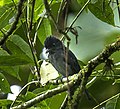 | Pachyramphus spodiurus | Slaty becard | Ecuador and far northern Peru. |
 | Pachyramphus rufus | Cinereous becard | Brazil, Colombia, Ecuador, French Guiana, Guyana, Panama, Peru, Suriname, and Venezuela |
 | Pachyramphus castaneus | Chestnut-crowned becard | Brazil, Colombia, Peru, Ecuador, and Bolivia and regions of Venezuela |
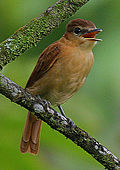 | Pachyramphus cinnamomeus | Cinnamon becard | south-eastern Mexico south to north-western Ecuador and north-western Venezuela |
 | Pachyramphus polychopterus | White-winged becard | Argentina, Belize, Bolivia, Brazil, Colombia, Costa Rica, Ecuador, French Guiana, Guatemala, Guyana, Honduras, Mexico, Nicaragua, Panama, Paraguay, Peru, Suriname, Trinidad and Tobago, Uruguay, and Venezuela. |
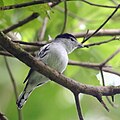 | Pachyramphus marginatus | Black-capped becard | Bolivia, Brazil, Colombia, Ecuador, French Guiana, Guyana, Peru, Suriname, and Venezuela. |
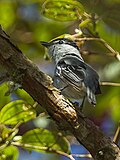 | Pachyramphus albogriseus | Black-and-white becard | Colombia, Costa Rica, Ecuador, Guatemala, Nicaragua, Panama, and Venezuela. |
 | Pachyramphus salvini | Cryptic becard | Ecuador and Peru. |
 | Pachyramphus major | Grey-collared becard | Belize, El Salvador, Guatemala, Honduras, Mexico, and Nicaragua. |
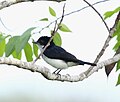 | Pachyramphus surinamus | Glossy-backed becard | Brazil, French Guiana, and Suriname. |
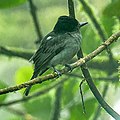 | Pachyramphus homochrous | One-colored becard | Colombia, Ecuador, Panama, Peru, and Venezuela. |
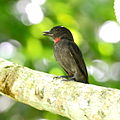 | Pachyramphus minor | Pink-throated becard | Bolivia, Brazil, Colombia, Ecuador, French Guiana, Guyana, Peru, Suriname, and Venezuela. |
 | Pachyramphus validus | Crested becard | Argentina, Bolivia, Brazil, Ecuador, Paraguay, and Peru. |
 | Pachyramphus aglaiae | Rose-throated becard | south-easternmost Arizona and extreme southern Texas of the United States to western Panama. |
 | Pachyramphus niger | Jamaican becard | Jamaica. |
Former species
Some authorities, either presently or formerly, recognize several additional species as belonging to the genus Pachyramphus including:
- Rusty-vented canastero (as Bathmidura Dorbignyi)[9]
Description
The becards are characterized by their large heads with a slight crest.[10] The smaller members of this genus have graduated tails and most members are sexually dimorphic, although the cinnamon becard[10] and the chestnut-crowned becard have similar plumages for the males and females. Juvenile becards resemble the adult females in plumage and, as far as known, obtain their adult plumage after about a year.[10] The bills of the becards are grey, and many (but not all) have a black culmen or upper mandible. Their legs are dark gray.[10]
Distribution and habitat
They are primarily found in Central and South America, but the rose-throated becard occurs as far north as southern United States and, as suggested by its common name, the Jamaican becard is restricted to Jamaica.[11] Depending on the species, they are found in wooded habitats ranging from open woodland to the dense canopy of rainforests.
Breeding
The nest of a becard is a bulky globular mass of dead leaves, mosses, and fibers with the entrance near the bottom of the nest.[10] Nests are typically wedged or slung from the outer branches of trees at the mid or upper levels.[10]
References
Wikiwand - on
Seamless Wikipedia browsing. On steroids.
